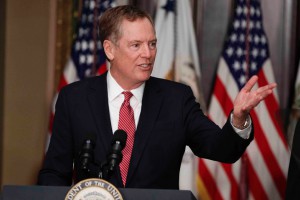Business groups from Canada, Mexican and the U.S stepped up this week to urge negotiators from all three countries to find common ground to maintain and improve the North American Free Trade Agreement, or NAFTA, even as Trump Administration policies take on a more protectionist hue.
The sixth round of negotiations to update NAFTA is beginning in Montreal the chambers of commerce from all three countries stressed that free trade keeps them prosperous and creating jobs.
We “urge our respective governments to come to an agreement to an updated NAFTA, and to maintain it for the future economic success of all three nations,” the leaders of 25 metropolitan chambers of commerce said in a statement.
The chambers, which represent economic zones with a combined GDP of nearly $3.5 trillion, said they “share a common desire to maintain free trade between the United States, Mexico and Canada.”
Noting that NAFTA has helped quadruple trade between the three countries since taking effect in 1994, now reaching $1.5 trillion annually, they also argued that multinational manufacturing value chains could be expensive to break up.
President Donald Trump wants to replace NAFTA with an agreement he says would be more beneficial to the United States.
(Ending NAFTA cripples U.S. trade, Clinton aide says. Click Here for the story.)
The six days of talks in Montreal come amid high trade tensions between Ottawa and Washington and as Trump insists Mexico will pay for the construction of a controversial wall along America’s southern border.
Despite significant progress on so-called “bread and butter” issues, Foreign Minister Chrystia Freeland says Canada is bracing for “the worst,” including a possible U.S. withdrawal from NAFTA that would effectively mean the end of the tripartite trade pact.
Having delivered on his promise to lower the corporate and personal tax rates, it’s not clear yet if Trump is willing to listen to his nominal allies in the business community.
(Click Here for more about the rise in Mexican imports in 2017, despite Trump pushback.)
Trump has at times also seemed to soften his view, telling The Wall Street Journal he would be “a little bit flexible” on his threat to withdraw because of the upcoming Mexican presidential election on July 1, in which major critics of the Trump Administration are gaining strength.
At the same time, however, Trump seems determined to use the protectionist policies to shore up his approval ratings, which are hovering near record lows despite record stock prices, low unemployment numbers and steady economic growth. A strong economy usually bolsters the incumbent administration, but Trump’s approval ratings haven’t changed much.
This week, the Trump Administration struck by imposing new tariffs on Chinese made washing machines and solar panels.
(To get the latest on NAFTA negotiations, Click Here.)
A report in the political web site Axios also noted this week that trade hawks like U.S. Trade Representative Robert Lighthizer appear to have gained ground in the White House while U.S. Secretary of Commerce Wilbur Ross, who was expected to sensitive to the concerns of business groups, appears to have faded in Trump’s estimation.

